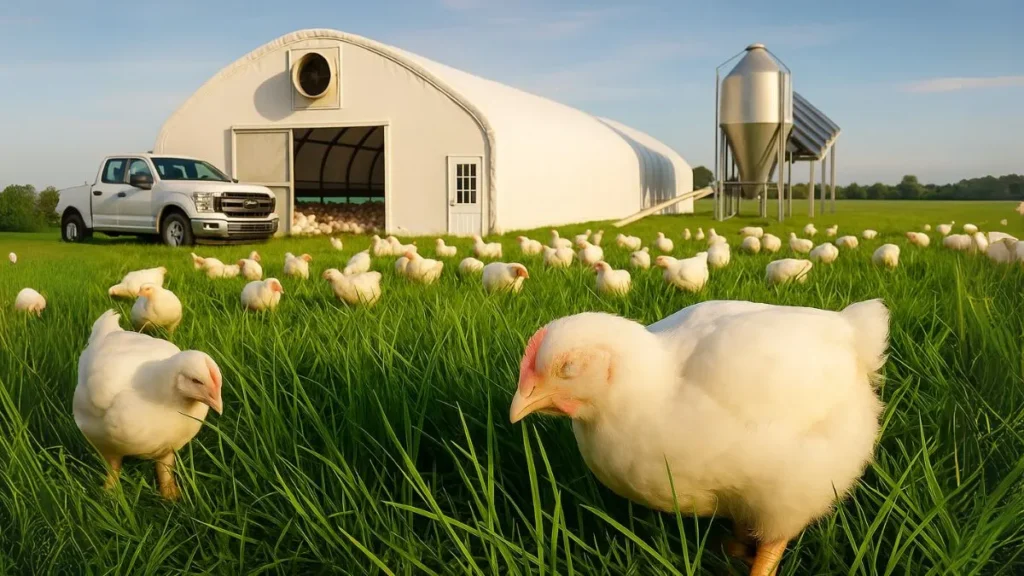What happens when ethical farming meets solar-powered innovation—on wheels?
Enter the mobile solar-powered chicken coop — a clever invention that’s quietly transforming the way we think about poultry. It’s not just about eggs anymore; it’s about sustainability, animal welfare, and the growing consumer demand for transparent food labels.
Let’s explore why this could redefine the future of free-range poultry farming and what it means for farmers, consumers, and the planet.
What Is a Mobile Solar Chicken Coop?
Imagine a greenhouse-like structure that moves across a pasture every day. Inside are chickens enjoying:
- Fresh grass and soil daily
- Natural bug hunting
- Ample shade and space
- A low-stress, cage-free life
Now add solar panels on top that power the ventilation and lighting—without tapping into the grid.
It’s called a solar-powered mobile chicken coop, and it’s part of a paddocking-inspired poultry system. By rotating location, it prevents overgrazing, promotes soil health, and reduces the feed bill for farmers.
Why This Innovation Matters
The global appetite for free-range, grass-fed, and natural catch products is booming. In the U.S. alone, the free-range poultry market has grown into a $2.3 billion industry.
Meanwhile:
- Labels like “organic”, “pasture-raised”, and “grass-fed” command premium pricing
- Consumers are willing to pay 20%–40% more for ethically raised meat and eggs
- Food overproduction remains a crisis: up to 40% of fresh food still goes to waste
This is where smart, scalable farming innovations step in—not just to increase supply, but to optimize sustainability across the board.

Key Benefits of Mobile Chicken Coops
1. Animal Welfare
The chickens live how nature intended—no overcrowding, no cages, no artificial feed reliance.
2. Soil Regeneration
Moving the coop daily allows natural manure distribution, preventing buildup and improving soil quality.
3. Energy Efficiency
Solar-powered poultry farming reduces the need for diesel, electricity, or mechanical fans.
4. Lower Feed Costs
Chickens get a significant portion of their nutrition by foraging—cutting down on processed feed expenses.
5. Carbon Monitoring
Modern platforms now allow tracking of environmental metrics like:
- Emission reduction
- Soil carbon capture
- Animal wellbeing audits
Which means farmers could verify and communicate the true ecological impact of every egg or chicken produced.
Also Read: From Wipro to the Cowshed: How Deepak Raj Tushir Is Transforming Rural India
Would You Pay More for Sustainable Eggs?
That’s the big question, isn’t it?
If you walked into a store and saw two cartons of eggs—one regular, and the other from a solar-powered, mobile chicken coop, clearly labeled with verifiable sustainability data…
Would you pay 20% more for the latter?
With climate awareness rising and ethical consumerism trending, many say yes. This isn’t just a fad—it might be the start of a systemic shift in how we view poultry farming.
Smart Poultry Farming: A Quiet Revolution
From free-range poultry farming to climate-conscious protein production, these emerging innovations could:
- Improve transparency in the supply chain
- Reduce dependence on fossil fuels
- Empower small-scale farmers with scalable, low-tech systems
- Restore consumer trust in food sourcing
As technology integrates more deeply with agriculture, we’re seeing a shift from high-input industrial farming to low-impact, regenerative systems—and poultry may lead the way.
Sustainability in Motion
The solar-powered mobile chicken coop may seem like a niche idea now—but so did vertical farming, drip irrigation, and farm-to-table just a decade ago.
The beauty of this model lies in its simplicity:
- Move the coop
- Power it with the sun
- Let chickens do what they naturally do
- Protect the soil
- Track the impact
With rising demand for sustainable farming practices, innovations like this could make ethical poultry production both scalable and profitable.
Click here to read more such stories on the Toronta Garden Book!



